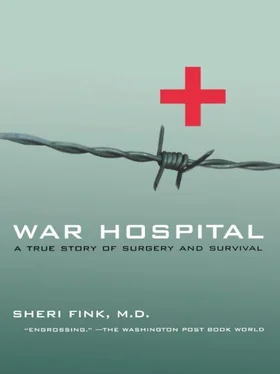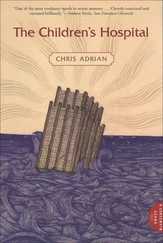Published Literature
NIOD Report: III/6/17 (events of July 11); III/5/11 (describes of the structure of the Serb forces participating in the attack on Srebrenica); III/7/3 (decision to call off air strikes—appears to be a combination of factors. Akashi may have already decided before receiving the message from the Netherlands Ministry of Defense ).
Interview with Christina Schmitz published in MSF’s magazine, Ins and Outs , Volume 7 number 9, November/December, 1995 (reports that MSF had thirteen local staff and collaborated with about 130 local medical staff; describes how she locked the shelter door assuming they’d be back the next day).
Rohde, Endgame, pp. 137–169, covers the events of July 11; Sudetic, Blood and Vengeance, p. 288, provides a beautiful and chilling description of the NATO air strikes.
van Laerhoven, Bob, Srebrenica, Chapter 5 (transcript of interview with Ilijaz not long after the time of the attacks).
Documents
U.N. Srebrenica Report, sections: 297–301 (confusion over air support requests morning of July 11), 302–303 (resumption of attack on Srebrenica on July 11 and shelling of Dutchbat B Company), 304 (Serb forces enter Srebrenica), 305–306 (NATO air strikes and the decision to halt them), 308 (“very easy target”)
MSF unpublished documents: MSF Srebrenica final situation report covering July 6–21, 1995 (decision to evacuate hospital, locals invoke Vukovar; MSF’s evacuation from Srebrenica); MSF security plans (e.g., 1994 plan by Isabel Ollieuz); MSF telexes on July 11 with information on number of patients and people (65/30,000) in Potočari.
Hospital documents: Hospital staff list, “Spisak radnike u Opštoj bolnici u Srebrenici,” March 7, 1994, lists 125 local hospital workers.
Krstić judgment describes panic in Potočari.
Other Materials
Film, The Fall of Srebrenica, 1996 with footage of people fleeing was used to describe the scene. Video taken by Belgrade TV journalist Zoran Petrović (including missing pieces broadcast on Dutch IKON TV April 11, 2002, and viewable on the Website domovina.net).
Notes
PAGE 290 The yard of Srebrenica Hospital… The mysterious fog in the sky and the inhabitants’ widespread belief that it was the work of NATO were described by several of the inhabitants interviewed and mentioned in the situation report Christina sent to MSF Belgrade at 06:51 UTC. The NIOD (III/6/18) asserts that the phenomenon was in fact caused by Bosnian Serbs, ordered by Gen. Ratko Mladić to set fire to haystacks, creating a smokescreen to to obscure potential targets.
PAGE 290 In Zagreb, Croatia… It is also notable that while Karremans expected air strikes (one of two air options; it had to be initiated by higher levels of the U.N. command structure and would not have been as dependent on moment-to-moment action on the ground), only close air support was ever on the table. Close air support required a target list with smoking guns. To this day, there is confusion over why Karremans apparently believed that air strikes were coming, when no such option had been decided upon at higher levels (Zagreb, Sarajevo) of UNPROFOR command.
PAGE 292 “What do you want?” This exchange is presented as Ilijaz recalled it.
PAGE 293 “Christina,” he begins… This interchange is presented as it was recounted by the translator, Damir Ibrahimović, who later survived the fall of Srebrenica by walking through the woods to Tuzla. Christina did not recall the specific conversation, but agreed that she wouldn’t have guaranteed anyone’s protection.
PAGE 293 “No,” she answers. In some security crises, local staff members of humanitarian agencies have preferred to remain in their homes with their families.
PAGE 294 Another local aid worker… These interchanges were recalled in detail by the local aid worker (Muhamed Duraković), but only in general terms by Christina, who said that she feared misuse of the telex for military purposes. Interviewed years after the incident, Dr. Daniel O’Brien also could not recall having been asked for morphine, but was almost certain that nothing but pentazocine remained in the medical stocks.
PAGES 294–295 Ilijaz crosses the street… Roughly a half dozen hospital staff were interviewed about the meeting and recalled it, but each had different memories of when it occurred and what was said by whom. Ilijaz insists that he advised men to go through the woods and women who hadn’t been part of the military to seek refuge at the Dutchbat compound. Someone else recalls him advocating a different position. This telling reflects the various opinions that were expressed.
PAGE 297 “Come on,” he says. This is Ilijaz’s version of the exchange. Naim recalls telling Ilijaz, “We have a 1 percent chance if we go to the forest, but if we go to Potočari, we haven’t got any chance.”
PAGE 304 They go back out. The account of Boro’s entry into Srebrenica is based entirely on his recollections.
Note
The account of the doctors’ exodus through the woods took Ilijaz Pilav’s personal recollections as a base, related in dozens of interviews. Interviews with others who traveled with him, including Naim, Fatima, Ajka, Nijaz, Avdo, Dževad, HadŽo, Asim and Hakija, confirmed many of the details. Their memories were checked against other accounts, and the timing of certain events had to be estimated. People’s recollections of a time when they were suffering from extreme stress and prolonged sleep deprivation will undoubtedly have many errors, particularly in terms of the sequence of events, so this chapter must be viewed as a best approximation of what actually happened.
Interviews
Ajka Avdić, Dr. Dževad Džananović, Hadžo Gadžo, Dr. Avdo Hasanović Dr. Fatima Klempić-Dautbašić, Dr. Gerry Kremer, Asim Lučanin, Stephane Oberreit, Dr. Daniel O’Brien, Hakija Meholjić, Dr. Ilijaz Pilav, Naim Salkić, Nijaz Salkić, Christina Schmitz.
Published Literature
de Barros-Duchêne, Srebrenica, pp. 111–124; NIOD Report: (Rumors of the fall of Žepa, panic the night of July 11, details of the deportations and separation of men in Potočari on July 12 and 13; the story of the Dutchbat medical orderly who found the woman being raped; story by MSF worker Emira Selimović that bodies were found and Christina was asked to go see them; the story of the first group of wounded and medical staff that were supposed to be evacuated, but were forced back to Bratunac instead and some taken away).
van Laerhoven, Srebrenica, Chapter 6 (Serb megaphone calls during the group’s rest by the river on July 12; lining up to walk again on July 13; Ilijaz’s view of the final battle). Rohde, Endgame, p. 194, describes the appearance of Serb troops who barged into Potočari on July 12.
Documents
U.N. Srebrenica Report section 394 (Serb radio reports the imminent fall of Žepa).
Krstić judgment (decision to inform the column on the evening of July 11 that they are going to Tuzla; information on the artillery attack that split the line near the main road on the twelfth and the tactics, including the use of megaphones and stolen Dutch uniforms, used to draw men to surrender; details of the atrocities that took place in Potočari, the deportations, the forced evacuation of the Dutchbat compound; the men on the list remain missing.)
MSF: Christina’s situation reports to Belgrade about July 12 in Potočari, e.g., 6:12 P.M. (reporting that thirty-five men are being guarded in a nearby house); 9 P.M. (“It’s horrifying outside… ”), and July 13, e.g., 11:30 A.M. (being asked to look at dead bodies, situation of patients, zero hospital mortality); a note back from Belgrade advising her not to investigate the dead bodies; 4:25 P.M. (she’s going back to Srebrenica); 5 P.M. (she insists the male medical staff stay with her).
Читать дальше












